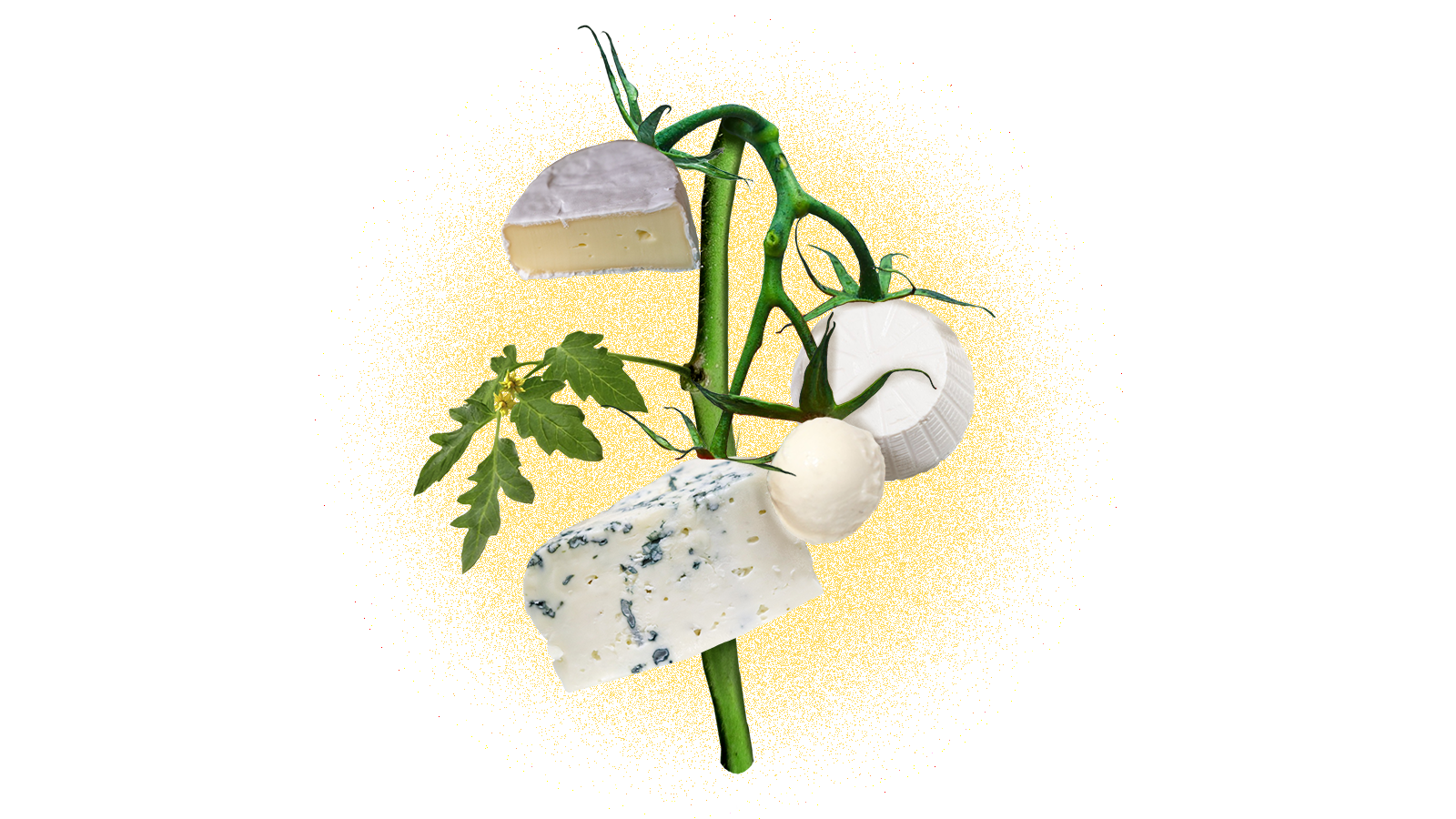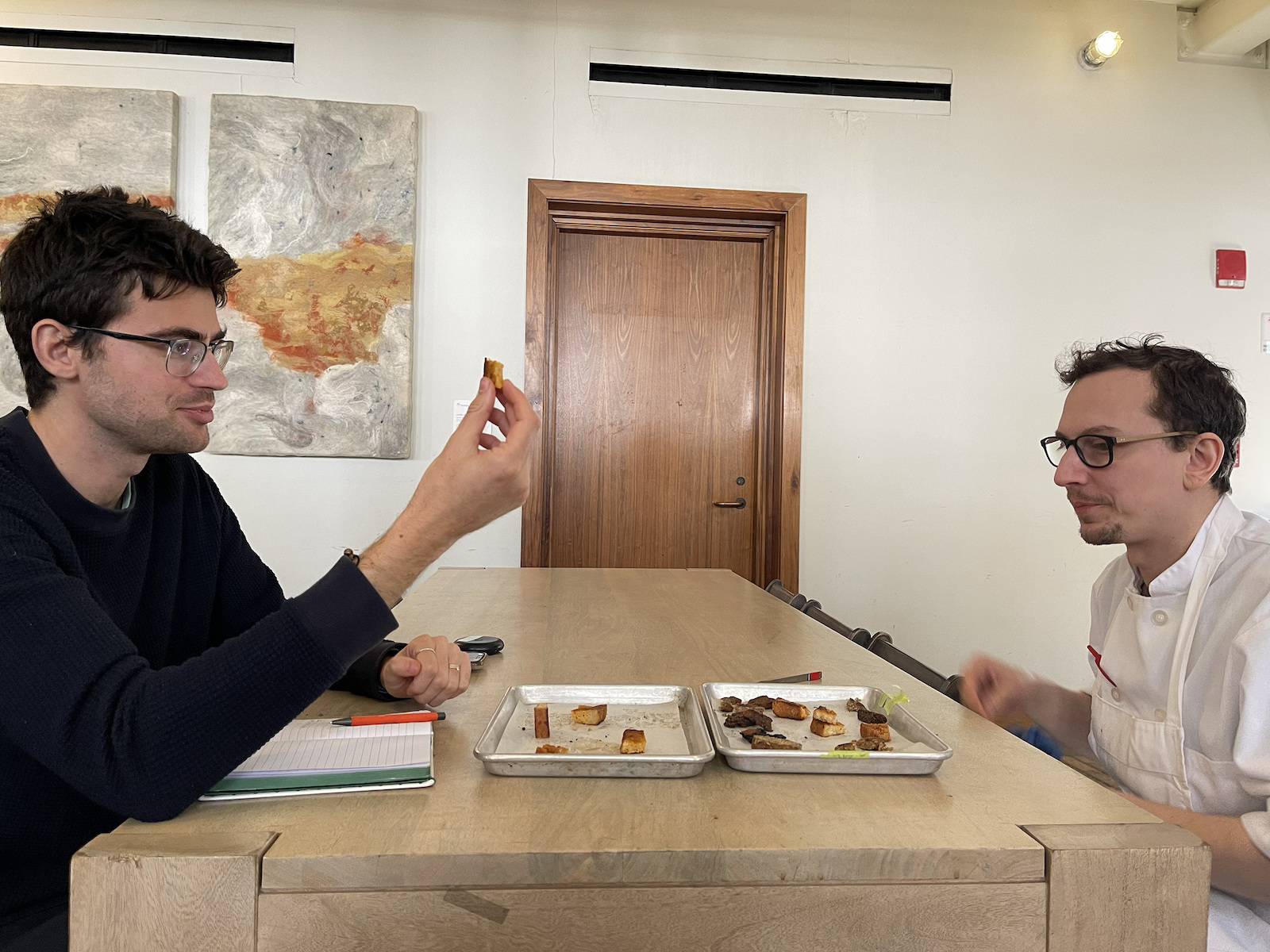Making oncom is sort of magical. It begins with a pile of soy pulp, which is wrapped in banana leaves and sprinkled with the spores of a fungus referred to as Neurospora intermedia. The bundle is left to ferment in a heat, humid place for a couple of day and a half. Because the mildew digests the proteins and starch inside the fibrous pulp, it additionally breaks down the cellulose, turning what stays right into a dish beloved by many throughout western Indonesia.
“It’s fairly astonishing,” stated chef-turned-bioengineer Vayu Hill-Maini. “In simply 36 hours, this fungal progress is de facto sort of remodeling what in any other case is fairly inedible.”
He hopes others see it that method, too. In a lately revealed paper in Nature Microbiology, the Stanford College assistant professor made a convincing argument that fungal fermentation of meals waste and agricultural byproducts may very well be the following culinary frontier.
For Hill-Maini, that is about greater than making stylish dishes. It’s about bettering meals sustainability and lowering starvation worldwide. The method he’s so enthusiastic about has been doing precisely that for hundreds of years in elements of Indonesia, the place oncom, a conventional staple, is an inexpensive and nutritious different to animal protein.
Patrick Farrell / UC Berkeley
Stir-fried; used as a stuffing, filling, or foundation of sauce; and even served as a fried snack, oncom is historically made by combining a little bit of previous oncom with one thing like soybean pulp and leaving it to ferment. It’s very like making miso, and ends in a protein much like tempeh. Its prevalence in Southeast Asian delicacies impressed Hill-Maini, who as soon as labored as a chef, to research the spore-bearing organisms behind the dish and determine how the fungus that creates it may very well be embraced worldwide.
Fermentation has been round for 1000’s of years. It’s what makes beer and wine attainable, and has lengthy been used to whip up kitchen-table fixtures akin to kimchi, sauerkraut, and yogurt. It’s even behind kombucha and sourdough bread. However it seems this chemical course of, during which micro organism, molds or yeasts break down sugar to create less complicated compounds, might assist alleviate the mounting disaster of meals waste. Hill-Maini thinks it might try this, in principle, by turning waste generated in the course of the manufacturing of plant-based milks into cheap and extremely nutritious dishes, serving to rein in a key supply of the greenhouse fuel emissions generated by the world’s meals system.
“We’ve identified for a few years that fungi are nature’s degraders,” stated Hill-Maini, noting that fungi used to cut back streams of meals waste may very well be the “most effective approach to convert waste into human meals.”

Hill-Maini’s paper is the results of three years of investigating simply the place N. intermedia might develop, and whether or not it might flip the cast-offs and refuse of commercial meals processing into one thing folks would need to eat. After analyzing every part from espresso grounds to orange peels — some 30 issues in all — he and his crew found that the pressure of fungus grows on most every part they tried. Additionally they discovered it didn’t produce mycotoxins, the possibly lethal substances related to some fungi.
And, maybe most notably, it resulted within the creation of meals that repurpose what would possibly in any other case find yourself within the rubbish with out sacrificing style within the curiosity of altruism. Equally vital, he needed the method extensively accessible.
“That is industrial-scale. It’s not compost bins and residential kitchens. It’s large industries that generate food-waste-grade merchandise each single day,” stated Hill-Maini.
The analysis centered specific consideration on what’s left behind in the course of the manufacturing of plant-based dairy, produce, and brewing. Apparently sufficient, Hill-Maini found many of those inedible objects may very well be reworked into one thing with appetizing colours, textures, and flavors.
This may very well be a boon for the local weather, as a result of proof suggests each metric ton of moist waste that’s upcycled by means of fermentation — on this case, became dinner as a substitute of touchdown into methane-spewing landfills — prevents the discharge of about 600 kilograms of CO2. Earlier than lengthy, Hill-Maini wish to see fungal fermentation integrated into meals manufacturing amenities and any rising refuse instantly reworked by mildew.
However what actually fascinates him are the local weather advantages N. intermedia might present. “What we’re pondering is we are able to convert this waste into protein, after which that protein can scale back animal consumption,” stated Hill-Maini. “We would be capable to have an enormous affect.”
Drumming up sufficient U.S. client curiosity in meals produced from waste would require a pitch that goes past the more and more futile message “that is higher for the planet.” However that sort of branding will not be obligatory. Rick von Hagn, who has spent the previous few years experimenting with N. intermedia at Blue Hill at Stone Barns, says the style and texture of this historic method of cooking could do the trick by itself. The farm-to-table restaurant in Tarrytown, New York has begun serving fungus-fermented meals in a handful of dishes.
His journey with the spore began in 2022, when he and colleague Andrew Luzmore started collaborating with Hill-Maini, figuring out numerous kitchen waste streams that is perhaps good candidates for fermentation. They’d ship one thing to the bioengineer, who would ship again a fermented meals, the primary of which started as “the press-cake that’s left whenever you make flaxseed oil,” stated Luzmore. “I keep in mind taking out what seemed like a burger patty and inserting it in a sizzling pan. Because it cooked it began wanting like a well-seared steak.”
They’ve since found that combining the fungus with a variety of substances gives a texture and taste additive that may rework even the trickiest alt-protein dishes right into a culinary star. The 2 cooks have used N. intermedia to enhance the feel of sausages made with a combination of meat and grains or greens, and introduced rock-hard bread “again to life” by fermenting it with the fungus and preserving it out of native landfills. The rejuvenated bread “has the feel of French toast and the flavour of grilled cheese.” Because it ferments, N. intermedia takes on an “earthy, floral high quality,” von Hagn famous, and cooking it gives “a tacky, deeply savory, mushroom-y taste and aroma.”

Utilizing the fungus in dishes has been such a success with prospects that the crew at Blue Hill has constructed its personal microbiology lab to guage the potential of fermenting numerous issues and creating recipes with them. It’s, as Luzmore described it, “a key to an entire new set of prospects which have largely remained unexplored past its conventional use in Indonesia.”
Matthew Kammerer, govt chef at The Harbor Home Inn in Elk, California, loves that concept. “Any cooking that’s executed with byproducts or became one thing distinctive to restrict meals waste is one thing I’ll all the time undoubtedly help,” stated Kammerer, who has not been concerned with the analysis challenge.
For the final seven years, Kammerer has been working with koji mildew, or Aspergillus oryzae, which is extensively utilized in Japanese delicacies to ferment soybeans and make issues like soy sauce and miso. Within the final decade, “koji’s sort of been the star of the present, nevertheless it looks like a really comparable course of and approach,” stated Kammerer. He’s excited about studying extra about N. intermedia’s gastronomic potential, which he dubs “far much less mainstream.”
All informed, it’s not simply fine-dining eating places within the U.S. that may be discovered embracing the culinary novelty of this Indonesian approach. Hill-Maini is now collaborating with San Sebastián, a Michelin-starred restaurant in Spain, with the goal to develop alcoholic drinks utilizing N. intermedia. Cooks at Alchemist, a Michelin-starred restaurant in Denmark, have created a dessert during which its fungal enzymes improve the sweetness and taste of a sugarless rice custard.

Vayu Hill-Maini / UC Berkeley
The most important barrier to the adoption of this pressure of fungus is the dearth of locations to purchase the spores wanted to develop it within the U.S. In Java, the Indonesian birthplace of oncom, oncom leftovers are used very like seeds to develop a brand new batch of the choice protein — a course of much like utilizing sourdough starter to make bread. In California, Hill-Maini’s crew used a lab pattern of N. intermedia to hold out its analysis. That restricted availability is one motive Luzmore and von Hagn went all-in on a microbiology lab, whereas Hill-Maini is constructing a kitchen alongside his laboratory at Stanford.
In fact, the steeper hurdle is getting folks to eat one thing that many view as rubbish.
“There’s a couple of issues working towards us. We’re speaking about waste, we’re speaking about mildew. When you say ‘mold-fermented waste,’ I believe folks might be actually turned off and disgusted,” he stated. That’s the place having fine-dining cooks will help flip folks’s aversion to inclination.
The irony is fermented meals merchandise, like sourdough, and people rife with fungi, akin to blue cheese, have lengthy reigned over the meals scene within the U.S. Kombucha — the beloved moldy, fermented drink that hit astronomical recognition in current years however was first brewed millennia in the past — is one such success story. Hill-Maini hopes to see the same sort of rocket-like trajectory for N. intermedia.
Embracing a food-waste-fighting fungus on kitchen tables and restaurant plates internationally shouldn’t be the way forward for meals, stated Hill-Maini, however the current. “Look, that is occurring in Indonesia. It’s occurring within the U.S. in numerous methods,” he stated. “That is only a new method to have a look at it, in the direction of planetary well being.”
He and his crew aren’t re-inventing the wheel, however rolling it into a brand new a part of the world as a drive for planetary good. One discarded pile of oat pulp or moldy loaf of bread, at a time.




